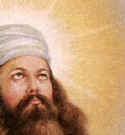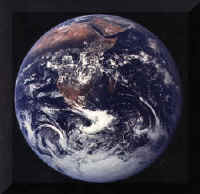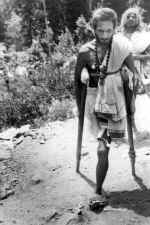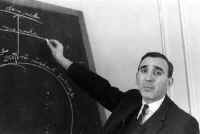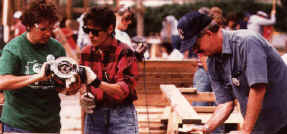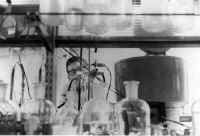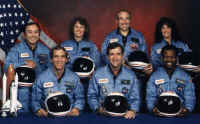Volume 11
Your Verdict
Editor's Note: A central aspect of Zarathushtra's teaching is that the ideals of religion find their best expression in the way we live our lives, in our thoughts, our words and our actions.
I therefore thought that it might be an interesting experiment to include in these materials photographs depicting certain ideas and solicit letters in which the readers could express their opinions regarding what aspects of Zarathushtra's teachings the photos depict. I hasten to stress: THERE ARE NO "RIGHT" ANSWERS. The whole idea was to have you express your opinions, whatever they might be.
Most of the photos were supplied by Sam Tata, a world class photographer whose photographs have been widely published in the media, and also hang in the museums of Europe and North America. I would like to thank Sam for taking the time and trouble to review his collection of photographs and give us the benefit of his selections.
Some of his photos are bitter-sweet -- like life itself. All of them are works of art. When an oyster takes in a grain of sand, it spins layers of pearl around it to cover the irritation. There are no pearly coatings in Sam's photos. His realities are sometimes stark, but they reflect a dedication to truth, a benevolent eye, and a perception of inner workings, all of which are the characteristics of a fine artist. Sam, we are in your debt.
My thanks also to those of you who took the time to write in. The views expressed by any one letter-writer do not necessarily reflect the views of any other letter writer, or the Editor. Without more ado, here are the photos and the letters that make up Your Verdict.
Photo No. 1, The Earth from Space,
(Courtesy of NASA).
We associate this photograph with Zarathushtra the first environmentalist! He first preached harmony between man and nature. In the world of today, this is the big issue of the 90s! But Zarathushtra proclaimed a respect for Nature and the environment thousands of years ago!
Roshan & Rohinton Rivetna,
Hinsdale, IL.
I can best see the principle of Asha represented. In the heart of this concept, we find an essential foundation of the Prophet's message to humankind. He tells us that Ahura Mazda conceived ideal creation in accordance with Asha. It represents the true order of the universe, being the law of truth, progress, justice, goodness and love. From Asha proceeds the harmony of universal law and order which encompass the whole of manifested creation.
Furthermore, our role as free individuals would be to better this world through righteous deeds; otherwise, we will forfeit Asha and will not be considered a part of this order. Zarathushtra explains qualities of a devoted Mazdayasnan as one who upholds the Truth in Ahunavaiti Gatha:
"These things are clear to the man of insight: He who upholds Truth with all the might of his power, he who upholds Truth to the utmost in his word and deed, he indeed is Thy most valued helper, O Ahura Mazda! " (Y31.22).
Thus, if we choose Asha by our free will, we will become collaborators with God in making the world progress towards perfection through our good thoughts, good words, and good deeds.
A. Makki,
Dayton, OH.
Regarding Photo No. 1, I would conjecture that it bears relevance to:
(1) Y44.3-4 ("This do I ask Ahura -- who laid down paths for the sun and stars, who made the moon to wax and wane betimes, whose might holds the earth and the sky apart...")
(2) Hormuzd Yasht para 26 ("through my own wisdom and perception I created this earth from the very beginning..." and
(3) Y47.3 ("Thou didst create this earth to give us joy...").
Homi Homji,
Weston, Ontario.
The photograph instantly brought to my mind the Gathic verse:
"This I ask You, tell me truly, Lord. Who holds the earth below, who keeps the sky from breaking away? Who created the waters and who the plants? Who lends the wind and clouds speed? Who is the creator, Wise One, of good mind?" (Y44.4).
Ali A. Jafarey,
Buena Park, CA.
This well-known photo gives us a perspective of our Earth as just one small planet among millions of stars and planets in the universe... Our ancestor, long before their eventual migration to Iran, were "star-gazers".
In the long, long dark winters of their northern habitats, they had the time and the burning desire to study the movements of the planets and the stars and formulate the early beginnings of astronomy.
Zarathushtra was equally fascinated with the vastness of the universe and who created it. He visualized a High God, Ahura Mazda (All Wise Creative Activity) as the Architect of the universe -- physical, mental, spiritual. He viewed Ahura Mazda as the point of origin.
He saw the essential unity of the universe -- an entire creation forging its way toward the goal of perfection. This is a fantastic cosmological transcendence of Ahura Mazda from the much narrower concept of God as a historic, personalized, religious deity...In Zarathushtra's own words, he pays homage to Ahura Mazda:
"When I conceived of Thee, O Mazda, in my mind, I sincerely regarded Thee as the first Actor in the Universe, as the Father of Reason, Good Mind, as the true Originator of the Law of Asha, as the Governor over the actions of Mankind."
Keki R. Bhote,
Glencoe, IL.
The photograph depicts to my mind peace and tranquility on the one hand and ferocity and destruction on the other. This corresponds to the teachings of Zarathushtra that there are two forces -- Spenta Mainyu and Angre Mainyu. He has taught to always be with Vohu Mano so that we can always think good, which will create good actions and improve our behaviour, so that we may find happiness on the earth and aspire to attain everlasting peace (behest) hereafter. (Y28.3).
Jamshed Pavri,
Vancouver, BC.
Ed: This letter was sent in on October 9, 1989, before Mr. Pavri's death.
This beautiful photo of the earth from space depicts the existence of light and darkness, of good and evil in this world. Light and darkness are intertwined; there are no demarcation lines and nobody knows exactly where goodness ends and evil starts. The glorious sunset on the right indicates that there will be darkness for sometime. This is referred to by Y34.7
"Wise One, where are those sincere ones who, through their possession of good thinking, make even immoral decrees and painful legacies disappear?..." (Y34.7) (Insler translation). (Insler translation).
In the meantime, we are groping to find our way in this maze of darkness and light, trying to grasp what is good and what is evil, often faced or overcome by evil forces. Y45.9 refers to this:
"...Him, who left to our will (to choose between) the virtuous and the unvirtuous..." (Y45.9) (Insler translation).
However, the sunrise on the left of the photo gives us hope that goodness will ultimately prevail. This is referred to by Y50.5:
"Let wisdom come in the company of truth across the earth!" (Y50.5) (Insler translation). (Insler translation).
Lien Patel,
Ottawa, Ontario.
[Ed: Pervin J. Mistry of Mississauga, Ontario has refused consent to the re-printing of any of her letters here].
The earth as we know is round. There are millions and millions of people, creatures and animals on the earth. Without earth there would have been nothing. Zarathushtra's teachings are not to destroy the earth....and to keep it clean. To grow vegetables and fruits, flowers, trees and raise animals which are very useful to human beings. It is the earth that gives us everything. Without the earth there would not be anything. It is like a mother to us. We are thankful to Ahuramazda for giving us such a precious thing.
Rashida Daruwalla,
Gaithersburg, MD.
This photo makes me appreciate that light and darkness are both beautiful, and that evil does not exist in the material creation, only in the thoughts, words and deeds of living beings. It also makes me appreciate how inconsequential are the differences that divide us. From up there it looks like one world.
Dina G. McIntyre,,
Glenshaw, PA..
Photo No. 2, Boy Studying Tropical Fish. © Sam Tata, 1958.
This photograph, (and also Photo 3c, The Professor), depicts a value held in the highest regard by Zarathushtra, Vohu Manah, the Good Mind. Zarathushtra encourages man to think and reason before he can believe. The emphasis on developing the mind, and reasoning through knowledge and learning rather than blind faith, is a concept that was far ahead of his time, and most appealing to the modern generation.
Roshan & Rohinton Rivetna,
Hinsdale, IL.
The young boy is expanding his knowledge of living creatures... The quintessence of Zoroastrian theology is the Law of Asha -- the divine Master Plan that governs all creation. It states that there are laws that govern the physical world -- evolution, gravity, the atom, DNA, et cetera. Similarly, there are laws that govern the spiritual world, that establish standards for an ethical code of conduct. It is logical, therefore, that Zoroastrianism is not only concerned with the spiritual development of man, but also with the physical and scientific. Zarathushtra taught that the revelations of the divine order are found in nature itself and not in any one man's doctrine. He urged that each person should accept only those beliefs -- spiritual or scientific -- that he himself concluded to be true after independent observation, after hearing from authorities and after self-instruction about the nature of the universe:
"Do you listen with your own ears, do you look with the best inspiring divine intelligence, at the creed of your own choice, each man for himself, in order to instruct himself through our sages before the magnific events." (Y30.2).
Later generations that came after Zarathushtra pursued this spirit of scientific inquiry, but included them in the rituals of the religion. The principle of not polluting the earth, of washing hands before the Kusti prayer, and other practices that may appear quaint to modern man, have all been built on a strong scientific foundation -- remarkable for being conceived thousands of years ago.
Keki Bhote,
Glencoe, IL.
Modern man perceives himself to be the superior portion of God's creation and therefore has tried to share in God's control over the rest of His Creation. Man is setting himself up at middle management level.
North American Indians, Eskimos, and other primitive cultures perceive themselves on the same level as the rest of God's creation and so they respect and even worship animals, birds, trees, the land, air and water. They perceive as brothers and sisters all of God's creation; and show the love and respect they would to their brothers and sisters to all of God's creation (not just the human race).
Personally, I see no evidence of God appointing man to the middle management position. I find much wisdom and millennia of success in the way that primitive man has lived in harmony with his environment.
These thoughts are inspired by the readings on Asha and Sam Tata's photo. Man's inquisitive nature which comes through in Sam's photo, is good until Man starts to get bossy, a la middle management.
Homi P. Bam,
Orillia, Ontario.
The boy studying tropical fish: My verdict is that a fish kept in a closed jar is unnatural. It is just like a captive in prison. They like to stay under the blue deep water of the ocean. They swim freely with other fishes, grow abundant. They are countless. People for their hobby like to keep them in a tank, it is not fair in my opinion.
Rashida Daruwalla,
Gaithersburg, MD.
Ed: Three cheers for Rashida! I did not think of this aspect of the photo -- which is one of my favorites -- but I admire your sensitivity and respect for other life forms.
What strikes me in the photo is the awe and wonder, almost ecstacy in the facial expression of the boy. It is exciting to know and to be able to understand the meanings of things and to discover new ways and meanings, and understanding them. Without that excitement of discovery the point is missed and the process of discovery has lost its real meaning. Mr. Tata brings out this aspect of knowing and discovering in the photo, and thus brings another perspective to the scholarly discourses on the subject under discussion.
Asha as natural law means freedom to move, act, think, and make choices within the boundaries set by natural law. We as human beings have partially lost that instinct to do the right things and speak the right words, and we need guidance, intellect and knowledge to help us make the right choices in complex situations. But we are not totally lacking in inner directives: sometimes we have to sit down and digest accumulated and sometimes conflicting information.
The photo emphasizes the joy of an active and constructive mind, which in my view is a very important aspect of Asha.
Lien Patel,
Ottawa, Ontario.
Photo No. 2 ... reminds me of some of the teachings of Zarathushtra.
Zarathushtra named his God Ahura Mazda which can literally be translated as "Supreme Wisdom/Knowledge". This nomenclature is repeated very frequently in various ways in the Gathas. To the Prophet Ahura Mazda was the greatest symbol of Wisdom and to me as a follower of his teachings, I believe learning and knowledge leads to wisdom.
The principles embedded in Yasna 30.2 are: See, Study and Select. We are advised to use our senses to find the facts and with a "clear mind" make the right decision.
The fish reminds me of the deep respect that Zarathushtra shows for all forms of life and living -- human, animal and vegetation. Reflection of his thoughts surface in Yasna 29.1, 3, 5, 6; Y30.9, 10; Y32.14; Y34.14 et cetera.
Zarathushtra's Ahura Mazda is Absolute Goodness and everything good in the universe emanates from the Absolute Goodness. These attributes could be in abstract form such as good thoughts, words and deeds, or celestial bodies such as the sun, moon, stars, or familiar objects on the earth such as the beneficent animals, shepherds, farmers, et cetera.
It reminds me that the environment emanates from the Absolute Goodness and we should treat our surroundings with respect. Yasna 32.8, 10; Y43.4, 16; Y44.3, 20; Y50.14 all underline Zarathushtra's veneration for the environment.
S. Vafadari,
London, UK.
Quest for knowledge.
Sam Tata,
Montreal, Quebec.
3(a) Saddhu making his way to Amarnath, Kashmir,
(a place of pilgramage). © Sam Tata, 1955.
3(b) Rabbi and Children,
© Sam Tata, 1972,
3(c) The Professor.
© Sam Tata, 1958.
The entire human race is on a pilgrimage of some sort. While the saddhu in the photograph displays certain visible handicaps, we are all in a way starting with a handicap (visible or otherwise) to gain "Progress and Advancement as emphatically advocated by the Gathas". (Spenta Mainyu, Ali A. Jafarey, essay in No. 3, December 1989).
Through such a spiritual pilgrimage we are led closer to the truth. To quote Professor Insler "This was Zarathushtra's attitude, it should be ours as well."
Dina H. Austin,
Bramlea, Ontario.
We need the guidance of teachers and of our own conscience, but we also have to make the effort to seek guidance as expressed in the photo of the Saddhu. It requires an open mind and a willingness to learn -- a lifelong process.
Lien Patel,
Ottawa, Ontario.
Photo No. 3(a). The Saddhu making his pilgrimmage to Amarnath is seeking to get away from the world to pray and meditate. This is characteristic of many religions that advocate a studied detachment from worldly affairs in secluded ashrams, monastaries and convents.
Zoroastrianism, on the other hand, advocates man participating with zest in the arena of life. Not only is his mettle tested, with temptations and pitfalls all around, but he can contribute to its improvement. Work and life are intrinsically good. The true Zoroastrian does not seek refuge from them. He makes them better, through full participation! We talk today of the Puritan ethic, the work ethic. In recognition of Zarathushtra's teaching, it should be called the Zoroastrian ethic!
Photo No. 3(b) and 3(c). Both photos stress the importance of education and the role of the teacher. Zoroastrianism emphasizes both -- the thirst for knowledge, and coaching by the teacher. Man is enjoined to follow the path of Asha through knowledge, through devotion, through action -- what the Vedas call Gryana Yoga, Bhakti Yoga, Karma Yoga. Knowledge precedes the other two disciplines. And knowledge can come only from intensive study, listening to the teachers and experts in a particular field and then arriving at one's own conclusions. What a remarkable philosophy, free of the chains of dogma that stifles.
Keki R. Bhote,
Glencoe, IL.
This photograph depicts Asha and Good Mind. Although the Saddhu is lame, he goes on crutches with one leg walking to Amarnath, Kashmir, this shows his faith, zeal, love and courage for his religion.
Rashida Daruwalla,
Gaithersburg, MD.
[Ed: I regret I cannot print Bill Brawner's most interesting letter because I have been unable to locate him to get his permission, and he specifically asked (at the time his letter was sent in) that it be copyrighted.]
Photo No. 4, Heart Transplant Operation.
© Presbyterian University Hospital, Pittsburgh, PA, 1983.
As in Photo No. 2, this photo evokes the importance of science in Zoroastrianism. It also conjures up mankind's long march toward perfection.
Symbolically, the face mask in the operating theater has the same significance as the padan in Zoroastrian religious ceremonies. In the former, it is to prevent contamination for the patient. In the latter, it is to prevent contamination of the holy fire. In reality, it is to emphasize purity -- the purity of thought word and deed.
Further, a heart transplant has provided a major breakthrough in medical research and in the medical profession's ability to extend man's life. Similarly, in Zoroastrianism's adherence to the law of Asha, man is constantly encouraged to advance the spiritual and physical world in its march toward perfection.
Keki R. Bhote,
Glencoe, IL.
I see in this picture the spirit of healing and caring for humanity as personified by the surgeons who are doing the heart transplant operation. Even to contemplate such a delicate and difficult operation, the surgeons will have to be moved by the spirit and will to do good, to heal, to help (spenta mainyu) and in order to prepare for the operation the surgeons will have to acquire knowledge, make proper judgments and apply good thinking (vohu mano). I think Yasna 48.12 in Dr. Taraporewala's translation is applicable here:
"Such are indeed the Saviours of the Earth,
They follow duty's call, the call of love,
Mazda, they listen unto Vohu Mano" (Y48.12).
The combination of good spirit and good thinking brings to fruition the deed. Actions performed selflessly and with love, within the Divine/Natural Law (Asha) is a manifestation of the concept of Armaiti.
I think that a deed or an act done with the whole personality, physically, mentally and spiritually is a religious experience and could be considered an act of worship.
Lien Patel,
Ottawa, Ontario.
What aspect of Zarathushtra's teachings can one discern in an advanced medical breakthrough like the Heart Transplant Operation? The thought that comes to mind is the power of healing. In Photo No. 4 the surgeons wield a knife to heal a medical problem. But not all of us have the surgeon's expertise, nor is all healing concerned only with curing physical illness. While medical healing is a science, mankind is beset with numerous woes (spiritual) which defy scientific healing.
Maybe Zoroastrianism does have an answer for the wellbeing and happiness of people, as it enjoins one to practise healing by following Zarathushtra's message of Humata, Hukhta, Huvarshta (good thoughts, good words, good deeds). Experience shows that some kind of healing could best be achieved simply by the power of prayers and kind words.
Dina H. Austin,
Bramlea, Ontario.
My verdict is a good deed. Humat. According to Zarathushtra's teachings to save a human life from pain -- heart disease and bring him back to normal life.
Rashida Daruwalla,
Gaithersburg, MD.
Photo Collage No. 5. A Modern
Barn-Raising.
. A Modern
Barn-Raising.
© Christian Science Monitor -- Robert Harbison, 1989.
(Courtesy of the Christian Science Monitor).
Photo Collage No. 5. A Modern Barn-Raising. These photos capture the spirit of volunteer service within a community. Alexis de Tocqueville, the renowned French author, felt that it was this free giving of oneself in the service of fellow man that set America apart from the rest of the Western world. In our times, President Bush has given expression to this service as "a thousand points of light."
Zarathushtra, whose ancient religion is ideally suited to modern times, stressed the importance of service to the larger family of man. Zoroastrians capsulize his teachings in the well-known phrase Humata, Huktha, Huvarashta -- good thoughts, good words, good deeds. But it is mainly through good deeds that a man is judged by his community. Zarathushtra taught that it was not enough to be good, but to do good. It is only by helping others through sympathy, friendship, charity and social service that man is liberated from fleeting pleasures or self-aggrandizement and discovers lasting happiness.
Zoroastrians, through the ages, have made this teaching of Zarathushtra a centerpiece of their religion. The world over -- be it in India, or Iran or North America -- Zoroastrians are respected within their communities because of their charities and their giving of themselves in humanitarian causes.
No statement can do better justice to the spirit of service than Zarathushtra's own immortal words:
"Happiness to him who gives happiness to others." (Y43.1).
Keki R. Bhote,
Glencoe, IL.
Photo Collage No. 5, A Modern Barn-Raising, depicts Zarathushtra's teachings Wohu Kshatra. To give help, to give selfless service to our friends, relatives and neighbors.
Rashida D. Daruwalla,
Gaithersburg, MD.
I am impressed by the friendly spirit, the working together, and the status-less environment which these photos depict, and the happiness which results -- Gathic teachings being practiced by people who have never read the Gathas.
Dina G. McIntyre,
Glenshaw, PA.
Photo Collage No. 6.
No. 6(a) Research at Children's Hospital,
© Sam Tata, 1958.
No. 6(b) Visiting Nurse and Old Man
© Sam Tata, 1963.
No. 6(c) Boy Lighting Cigarette,
© Sam Tata, 1958.
The photographs which have dotted some of the lectures have been rather esoteric and initially I found it hard to relate to them in the context of the teachings of Zarathushtra in the Gathas. But after reflection and contemplation, the photographs came alive. I would like to express my verdict on a group of 4 photographs, No. 1 The Earth from Space, No. 2 Boy Studying Tropical Fish, No. 4 Heart Transplant Operation, and No. 6 (a) (b) and (c).
There appears to be a common theme in these four photographs, the continuity of life: from creation Asha and Fresho Kereti (Photo 1), to the quest for knowledge from Spenta Mainyu and Vohu Mana (Photo 2), to the highest application of knowledge in saving another's life (Photo 4) -- Vohu Xshathra the good rule of authority or power exercised with reason and intelligence and committed to what is true and right (Asha). Here we see Asha, the law of progress capable of accomodating modernity without any change in the essence of the law. Photo Collage No. 6 embodies the principles of Haurvatat and Ameretat; goodness for the sake of goodness, the realization of good thought, word and deed. Helping others selflessly brings its own reward (Ameretat). The continuity in this theme ends with the ending of life.
Dolly Dastur,
Brossard, Quebec.
To me it seems that each of these photos, 6(a)(b) and (c), in different ways, represent benevolent service to the rule of truth and good thinking (aramaiti): (a) represents the quest for knowledge or understanding, (b) and (c) represent individual acts of service stemming from good thinking
As a community, we like to pat ourselves on the back by pointing to the many magnificent philanthropic, financial charities which our ancestors in India and Iran have set up for their respective communities and nations. But as the saying goes: "That's history. What have you done recently."
Sam's photos bring home the point that one need not be a millionaire to engage in acts of benevolent service (aramaiti), and that small, ordinary, unpretentious, individual acts, sometimes unpleasant, often unnoticed, are that touch of sunlight that make life worthwhile. One such act may seem like nothing. But put them all together and you bring to life the "rule of truth and good thinking".
Dina G. McIntyre,
Glenshaw, PA.
No.6(a) To train the mind in quest of truth and wisdom is a laid-down principle of Zoroastrianism. No. 6(b) Youth will not forsake the aged: Is that not an essential duty enjoined by our faith? No.6(c) Although fire is held sacred in Zoroastrianism and smoking therefore is a no-no, the concept of compassion and care ... comes across strong in (c) -- a vital aspect of Zarathushtra's teachings.
Dina Austin,
Bramlea, Ontario.
Photo No. 7. The Challenger
Astronauts.
(Courtesy of NASA).
This photo represents man's quest to push forward the frontiers of knowledge and science. It illustrates... Zarathushtra's teaching of a spirit of free and independent inquiry.
Keki R. Bhote,
Glencoe, IL.
This photograph depicts to us, the Zoroastrian values of Action, the Spirit and the Love of life. The spirit of adventure and enterprise, the yearning for truth and knowledge, the striving "whether through spoken word, through firm resolve, or through the act direct..." (Y33.2). "Whoso fosters zealously all Life, he doth assure himself a place within the realm of Asha and Vohu Manah." (Y33.3).
Roshan & Rohinton Rivetna,
Hinsdale, IL.
The brotherhood of man.
Dina G. McIntyre,
Glenshaw, PA
